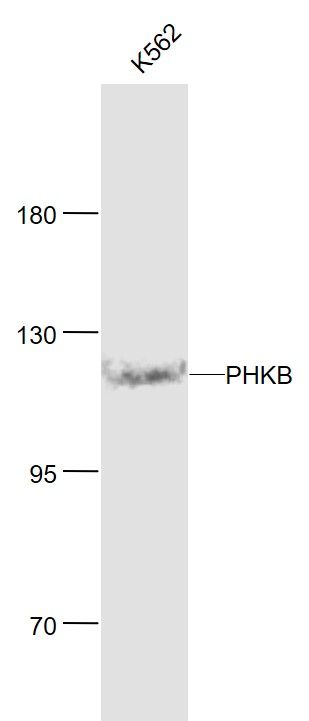Phosphorylase kinase is a polymer of 16 subunits, four each of alpha, beta, gamma and delta. The alpha subunit includes the skeletal muscle and hepatic isoforms, encoded by two different genes. The beta subunit is the same in both the muscle and hepatic isoforms, encoded by this gene, which is a member of the phosphorylase b kinase regulatory subunit family. The gamma subunit also includes the skeletal muscle and hepatic isoforms, encoded by two different genes. The delta subunit is a calmodulin and can be encoded by three different genes. The gamma subunits contain the active site of the enzyme, whereas the alpha and beta subunits have regulatory functions controlled by phosphorylation. The delta subunit mediates the dependence of the enzyme on calcium concentration. Mutations in this gene cause glycogen storage disease type 9B, also known as phosphorylase kinase deficiency of liver and muscle. Alternatively spliced transcript variants encoding different isoforms have been identified in this gene. Two pseudogenes have been found on chromosomes 14 and 20, respectively.[provided by RefSeq, Feb 2010].
Function:
Phosphorylase b kinase catalyzes the phosphorylation of serine in certain substrates, including troponin I. The beta chain acts as a regulatory unit and modulates the activity of the holoenzyme in response to phosphorylation.
Subunit:
Hexadecamer of 4 heterotetramers, each composed of alpha, beta, gamma, and delta subunits. Alpha (PHKA1 or PHKA2) and beta (PHKB) are regulatory subunits, gamma (PHKG1 or PHKG2) is the catalytic subunit, and delta is calmodulin.
Subcellular Location:
Cell membrane; Lipid-anchor; Cytoplasmic side (Potential).
Post-translational modifications:
Ser-701 is probably phosphorylated by PKA.
Although the final Cys may be farnesylated, the terminal tripeptide is probably not removed, and the SLCterminus is not methylated.
DISEASE:
Defects in PHKB are the cause of glycogen storage disease type 9B (GSD9B) [MIM:261750]; also known as phosphorylase kinase deficiency of liver and muscle (PKD). GSD9B is a metabolic disorder characterized by hepathomegaly, only slightly elevated transaminases and plasma lipids, clinical improvement with increasing age, and remarkably no clinical muscle involvement. Biochemical observations suggest that this mild phenotype is caused by an incomplete holoenzyme that lacks the beta subunit, but that may possess residual activity.
Similarity:
Belongs to the phosphorylase b kinase regulatory chain family.
SWISS:
Q9620
Gene ID:
5257
Database links:
Entrez Gene: 5257 Human
Entrez Gene: 102093 Mouse
Entrez Gene: 361377 Rat
Omim: 172490 Human
SwissProt: Q9620 Human
SwissProt: Q7TSH2 Mouse
Unigene: 78060 Human
Unigene: 237296 Mouse
Unigene: 6488 Rat
磷酸化酶A是磷酸化酶的活性状态,而磷酸化酶B是其无活性状态。6-磷酸葡萄糖结合磷酸化酶后,磷酸化酶由无活性变为活化态,的加长,之后,又回到原来无活性状态,它充当了个桥梁作用。
| Picture |
Sample:
K562 (Human) Cell Lysate at 30 ug
Primary: Anti- PHKB (SL4032R) at 1/1000 dilution
Secondary: IRDye800CW Goat Anti-Rabbit IgG at 1/20000 dilution
Predicted band size: 124 kD
Observed band size: 124 kD
|
|
|
